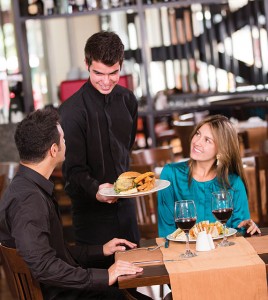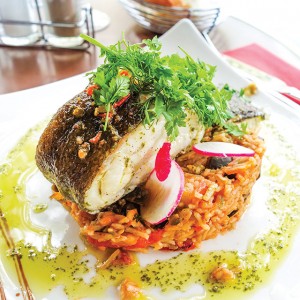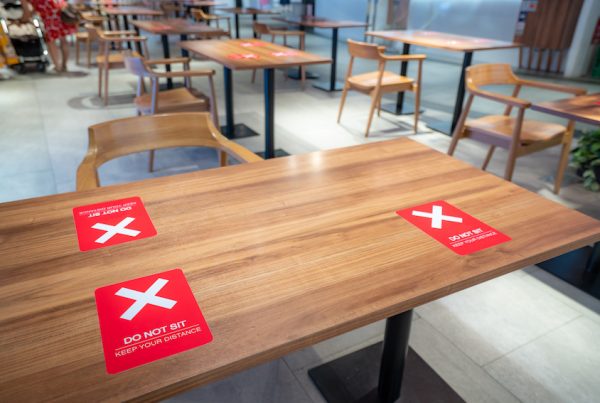Food certainly makes the world go round and each season sees new uptakes of new ingredients, the embrace of different ways of eating and in some cases, the welcoming back of older fads. The exciting thing about food culture is how trends can resonate whether in a macro or micro scale; partly due to the ability of culinary professionals to make it work with its audience. With that in mind, we will take a look at what’s emerging around the world; as seen through the eyes of experts, from the Consultants’ looking at how trends can affect food operators to food-loving people (bloggers) who share their thoughts from a diner’s perspective.
GLOBAL IDEAS
Eating Out – An Experience More Than Necessity Diners are increasingly getting in touch with the appreciation factor of food compared to having a mountain of food on their platter. Tasting menus are becoming more popular where one can enjoy a multi-course meal (although expensive) all in one place. And people do not seem to mind spending that kind of money to understand how ingredients, a chef’s skills, commendable service and dining ambience work together to create for them a memorable experience.
On the other spectrum, the North American Restaurant Consumer Sentiment Review by AlixPartners found that over 60% of its respondents are choosing to eat out less in 2014 for health reasons above the budget aspect. Meanwhile, Baum & Whiteman’s report talks about “green”, which encompasses a bigger picture than just vegetables but includes striving to maintain a balanced diet, go glutenfree, embracing vegetarianism and a greater awareness of farm-to-fork practices. Breakfast is making a return as an important meal with consumers looking at foods with whole grains and good protein to start their day with.
Health-conciousness might be in line with added convenience of online grocery shopping, the use of mobile apps for grocery lists and easy recipes. Respondents in the ConAgra Food Survey agreed that online shopping sites and tools to be helpful in finding recipes and in some instances, great deals offered by grocers near them.
Engaging Beyond Purchases
Food and fashion are in tandem according to Baum & Whiteman; and retail stores are beginning to merge two-inone. According to observation, given the ability to eat and drink increases the time patrons linger in the store; which in turn results in higher possibility of purchase. It is also an exercise in brand identification and reinforcement.
On a similar vein, grocery stores are raising their stakes with their own brands with 53% of consumers expressing loyalty to a retailer brand for its quality while 44% buy store brands for its value-for-money promise. In some communities, their local supermarkets are starting off endeavours such as “cooking centers” in the store; which is sort of an offshoot from the generous sharing of food ideas on social media. By bringing this culture offline, these stores can create an avenue that encourages its buyers to drop in on the regular; to learn and connect and at the same time do their shopping.
Speaking of social media, the younger crowd is definitely driving its adoption as they like to know beforehand what to expect from a restaurant; hence the website, fan page are important channels to reach out to them. Additional tools such as online ordering or promotions will help drive them there.
Traveling Taste Buds
Westerners are beginning to taste the wonders of Asian flavours. Think Lay’s sriracha potato chips or the Ramen Burger (Japanese noodles used in place of a burger bun), further introduction of Korean cuisine and such. Look forward to the influence from Middle East, Mexican, Greek, Latin, Halal/ Kosher and Indian foods as the world becomes increasingly borderless and people who emigrate form communities desiring to keep their distinct food cultures alive.
References:
http://www.foxnews.com/leisure/2013/11/07/top-12-hottestfood-and-beverage-trends-for-2014/
http://parade.condenast.com/231503/phil-lempert/2014-foodtrend-predictions/
http://nrn.com/consumer-trends/study-consumers-dine-out-lessoften-2014?page=2
CONSULTANT’S VIEW
A Consultant in the foodservice industry assists in bringing concepts to life by planning its layout on the external, the kitchen and advising on the necessary equipment according to the core of each business. They are the people who keep a close eye on the industry; understanding how the market shifts and providing insights to assist restaurateurs to achieve profitability and sustainability. Here are their thoughts on possibilities that will shape 2014:
 Carl Kjellqvist (CK)
Carl Kjellqvist (CK)
Focus Hospitality Inc.
carl@focushospitalityinc.com /
www.focushospitalityinc.com
Since entering the scene in 1988, Focus has been keeping its sights on providing technical and conceptual assistance to create exciting and sustainable food and beverage, lodging and retail related businesses, contributing its expertise in over 300 hospitality and retail related projects around the Americas, Europe, Middle East and the Asia Pacific. Focus operates in Singapore, New York, Paris and Perth.
 Robert Mang (RM)
Robert Mang (RM)
Dishes Independent Kitchen &
Laundry Consultants
robert@dishes.hk /
www.dishes.com.my
Its value of “No over specified Equipments, no over designed Facilities” ensures customers get what they need to maximise efficiency as the company is fully independent from any manufacturer. Dishes still looks to traditional concepts but implements new design trends in its F&B concepts, area planning and schematic designs. Dishes is headquartered in Malaysia with offices in Singapore, Hong Kong, Shenzen and Bangkok.
 David Kidney (DK)
David Kidney (DK)
Fabristeel
david.kidney@fabristeel.com.sg /
www.fabristeel.com.sg
Founded in 1979, the company undertakes the management of professional kitchen projects, offering turnkey services, from restaurant concept and facility design, to equipment specifications, in-house fabrications, installation and maintenance. Fabristeel is present in various countries through its manufacturing and production facilities, supply chain networks, sales offices and service networks.
• The public sees F & B as the evergreen industry yet it is also one with a high mortality rate. Should business operators expect any big changes for 2014 for the hospitality/food and beverage industry?
CK – It is the survival of the fittest. Those in developed markets can look into improving efficiency to reduce cost while developing market players fill the gaps by improving and offering greater products and services. Labour crunch is still an issue and businesses are looking at centralising cost centers, running lean outposts and offering value propositions to its customers. 2014 will be a year of consolidation on all fronts.
RM – I think it would be different from City to City/Country to Country. It is subject to the economy situation but I don’t feel that there are any big changes.
DK – I don’t expect to see major changes or a run on massive projects. Instead, companies and individuals will spend more time understanding what they are selling and what their clients actually NEED, for the price factor is a huge contributor to high mortality. There needs to be serious effort into doing the right thing instead of lowering prices. I totally acknowledge pricing is important, however it also has to reflect the fact we are dealing with machinery-it breaks down, it needs maintenance and it has options.
• What were the significant changes in Asia did you see happening in 2013 for the commercial kitchen or hospitality industry?
CK – The continued increase in Chinese tourists and business visitors. Hotels are starting to accelerate their realignment of their food service offerings (and kitchens) based on this along with an increase in Mandarin speaking staff. This is not a significant change per se but rather a gradual and ever important realignment. The hotel industry continues to outsource their food service offering or create cutting edge concepts that stand-alone restaurants can’t compete with in terms of fit-out expenditure and collaborating with celebrity/ Michelin star chefs. The growing convergence of retail and food service where wholesalers and distributors already serving the business-tobusiness market are expanding to include the end-consumer. Also, the convergence of retail and food service establishments through micro-tenancies whereby one or the other is placed within its space creates a mutually beneficial symbiosis.
DK – I see a probability that projects are being cut way below respectability and equipment being purchased for the wrong reasons, adaptation of certain Technology where it is not fully understood without maximum benefits it can provide its user.
 • Cost is always a factor. How can we stress the importance of the right equipment & the right design to business operators?
• Cost is always a factor. How can we stress the importance of the right equipment & the right design to business operators?
RM – I always treat an operation like a small factory. If I could find a piece of equipment which could help the operator to save cost on labour, I always recommend it. This is especially so where I am based, the labour cost has been rising and will continue in the coming years but cost of energy is still relatively more affordable.
DK – This is often totally messed up by an individual who sells on price alone; a simple but appropriate example…..you don’t see Starbucks skimping on the Coffee Equipment.
• Will there be any new concepts in dining out that would grow or materialise in 2014?
CK – Asians are more well-travelled and will eventually bring cuisine cultures home. Central and South America is the new culinary focus, although rather untapped but attention will stay given the upcoming World Cup and Olympic games in Brazil. While Spain and Scandinavia shared the spoils over the last few years, the next two years lies in nueva-
Latina cuisine and adaptations of it. The health focus will remain a significant force in the food service industry as people are becoming more aware of foods playing a role in a healthier lifestyle.
RM – A note on the healthy eating revolution; I personally see this as a gimmick more than a trend. Especially in my area of Hong Kong, it is not a picture of the general public’s dining habits for the Chinese always eat fresh except in some cities where they do not have the resources.
DK – If we are looking at the healthy and fresh eating trend, it really depends on the Menu size. It is very important a menu is sustainable and NOT fanciful with proper storage facility. The Supply Chain responds to demand over time so I don’t see too many issues, logistically speaking it all comes down to where the facility is; remoteness naturally presents added challenges and appropriate storage needs to be taken into consideration.
• Chains/fast food restaurants are growing, so is a growing group of knowledgeable consumers that drives the demand of fine dining restaurants. In 2014, how do you see these 2 vastly different businesses moving?
CK – Fine dining is expensive. It requires an uncompromising attitude towards finding the best produce and attention to service. The advent of the “celebrity chef” and knowledge empowerment on understanding ingredients continues to drive the demand. On the other hand the very same has forced the fast food industry to somewhat shift “upwards” towards the more informal dining with QSR establishments offering a “fresher” and “quality” driven experience.
RM – I believe both sectors will survive and will grow for some years as there is also demand from different market segment.
DK – QSR will certainly continue its march forward. I see this Industry looking inwardly at ensuring Service and Backup is focused where it should be as opposed to messing with pricing and then discovering there is Little or NO backup.
Dining whether casual or fine will be subjected to similar stresses it faces in the many Cities in and around the Region. The life span of many of these establishments is no doubt limited so a degree of wisdom is required in committing to set-up costs. While I acknowledge the overall ambience and persona as very important, the Heart of the House being the Food & Beverage facilities should not be the poor cousin – it does not mean you need the latest & greatest, but it means the appropriate equipment and functionality.
• Your advice to new investors to the industry, especially in 2014.
CK – Go big or small – I’m always of the opinion that anything in-between is more likely to fail.
Look to create or invest in concepts that showcase longevity rather than meet a specific and possibly short-lived trend.
Ensure that the operation is lean and operating systems can rely less on skilled labour and maintain consistency and product quality.
Embrace technology to reduce service and ordering time, engage and interact with customers through social media. Remember “value” doesn’t necessarily mean “cheap”; it is subjective based on the product offering.
Develop and or set up your operation with scalability in mind. Once you have a number of venues up and running, a centralised production facility will allow you to gain greater economies of scale AND attract outside investors and or potential franchisees / licensees.
• Were there any new equipment in the market that has changed or impacted the running of a commercial kitchen?
RM – While there were some new equipment, I didn’t think that it impacted the design of a commercial kitchen on a major scale. For example, freezing and rethermalising has become more efficient in the last few years but from my observation, it will take some time for the industry in China to fully embrace it.
In terms of commercial equipment, I’d like to see improvement in the technology of Food Waste Handling Equipment, Electric Cooking Equipment (induction is not the final solution), Knife Steriliser, Water Filter, Chiller/Freezer.
Adding to that, the important factors are durability, ease of use and maintenance as well as multi-functional. At the same time, some equipment might not be as necessary as before due to space constraints like bulky equipment in a standalone restaurant.
DK – Nothing startling, we see continuous effort from most manufacturers to be as innovative as possible. I feel there is a need to look at leaner kitchens to assist in skilled labour shortages in various locations. Styles of service like Sous Vide I feel are quite exciting and could be very beneficial to smaller operators. All technology/processes have their places; the economy of such has to be understood before implementation. Energy efficiency is always a good one but also NOT to over complicate …often LESS is more.
We wish to express our sincere gratitude to the Consultants for their time and contribution to this article.












